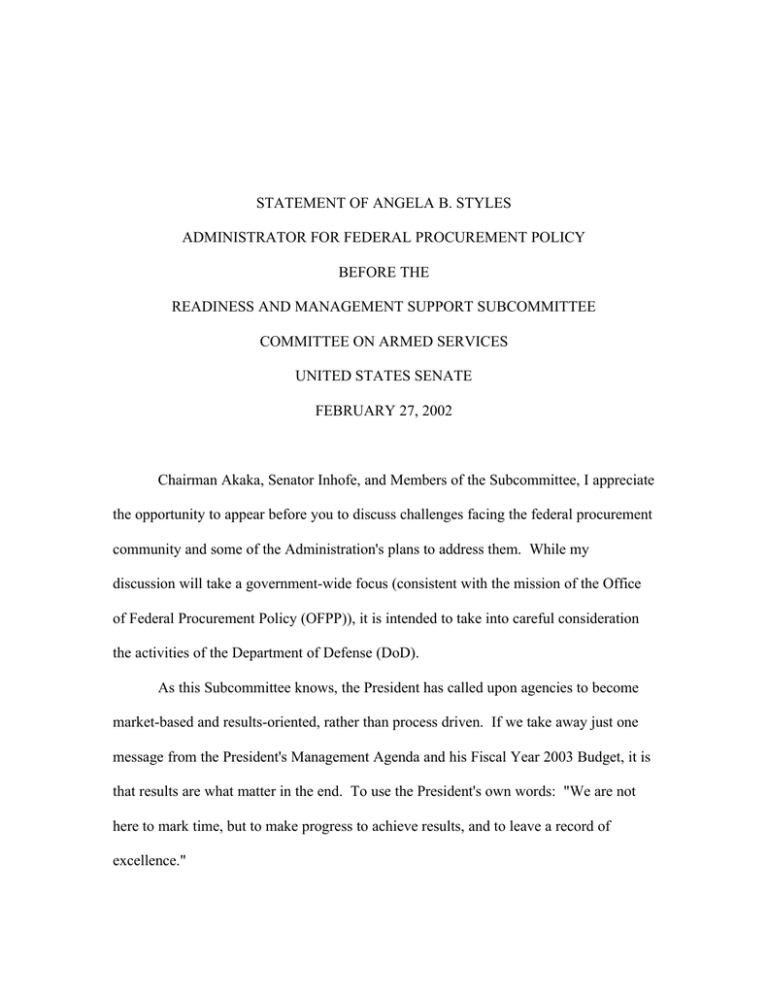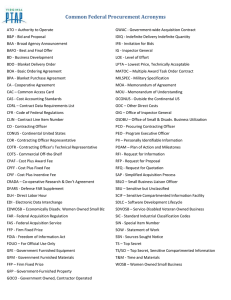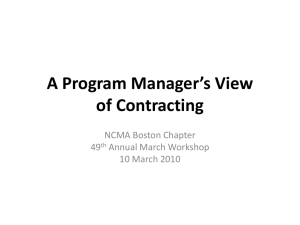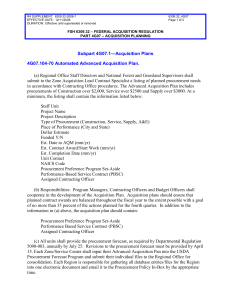STATEMENT OF ANGELA B. STYLES ADMINISTRATOR FOR FEDERAL PROCUREMENT POLICY BEFORE THE
advertisement

STATEMENT OF ANGELA B. STYLES ADMINISTRATOR FOR FEDERAL PROCUREMENT POLICY BEFORE THE READINESS AND MANAGEMENT SUPPORT SUBCOMMITTEE COMMITTEE ON ARMED SERVICES UNITED STATES SENATE FEBRUARY 27, 2002 Chairman Akaka, Senator Inhofe, and Members of the Subcommittee, I appreciate the opportunity to appear before you to discuss challenges facing the federal procurement community and some of the Administration's plans to address them. While my discussion will take a government-wide focus (consistent with the mission of the Office of Federal Procurement Policy (OFPP)), it is intended to take into careful consideration the activities of the Department of Defense (DoD). As this Subcommittee knows, the President has called upon agencies to become market-based and results-oriented, rather than process driven. If we take away just one message from the President's Management Agenda and his Fiscal Year 2003 Budget, it is that results are what matter in the end. To use the President's own words: "We are not here to mark time, but to make progress to achieve results, and to leave a record of excellence." 2 The President's message presents an important challenge -- and opportunity -- for agency procurement personnel. As the creators and guardians of the vehicles that most directly influence how effective contractors will be in helping to carry out the business of government, procurement personnel play a critical role in a performance-based environment. This role becomes even more vital at a time when the demands of national security assert a heavy claim on our Nation's resources. This morning, I would like to begin by describing for the Subcommittee the general challenge facing the federal procurement community, as I see it. Then, I would like to highlight some of the steps we are, or will be, taking so that procurement offices are effectively positioned to meet the President's goal to achieve results. Finally, I would like to comment briefly on a couple of procurement-related legislative initiatives. Managing the Procurement Process Thanks in significant part to Congress, our current procurement process provides agencies with a variety of contracting tools that can help them deliver many goods and services in far less time than it took just a decade ago. These tools include: purchase cards, the Multiple Award Schedules (MAS) contracts and multiple award task and delivery order contracts (which permit streamlined source selection processes for placing repetitive orders with pre-qualified contractors), and streamlined processes for conducting competitive negotiations for buys on the open market. While the operational efficiency made possible by these tools is understandably attractive to program offices, our ability to achieve good overall results also requires that acquisition processes take a balanced approach among all of the basic building blocks of 3 acquisition: sound planning, consistent use of competition, well structured contracts designed to produce cost-effective quality performance from contractors, and solid contract management. All of these activities must occur in an environment that fosters fairness, integrity, and transparency. Adherence to these values, and policies that promote them, will garner the public’s confidence and help to encourage robust participation in federal procurement by contractors small and large. Regrettably, we cannot remind ourselves enough of the need to follow the acquisition basics. Hardly a month seems to pass where Congress, the General Accounting Office (GAO), or agency Inspectors General aren't citing to lax application of these basic functions as a major contributor to shortfalls in program performance. Insufficient attention to requirements development, failure to perform vigorous price analyses, inconsistent use of competition, weak negotiations, and poorly structured contracts with ineffective incentives continue to plague even the most streamlined and protest proof of our acquisition tools and may be putting taxpayer dollars at risk. To improve performance, agencies must recognize that acquisitions are the shared responsibility of a variety of disciplines, including program, technical, contracting, financial, logistics and legal personnel. These disciplines must work together so the respective expertise that each offers is better integrated in agency decision making. In particular, program offices must be willing to commit sufficient attention to acquisition planning and contract management. They must understand that no amount of training on the part of procurement personnel and no degree of operational expediency afforded by contracting tools can serve as a substitute for these activities. 4 For their part, agency procurement officials must not allow pressures for expediency to divert attention away from the application of fundamental contracting principles that lie at the heart of any successful acquisition process, no matter the agency or the requirement. Far from the mechanical or administrative-laden label that some might like to assign to the contracting function, procurement personnel remain vital to ensuring the proper stewardship of the $220 billion in goods and services the federal government buys each year. These people are the key component of our acquisition workforce and are looked upon to ensure sound application of the varied contracting tools now available. For this reason, my office is taking steps -- albeit first steps -- to underscore the importance of acquisition basics. In doing so, it is my hope that the tools and concepts that have grown out of acquisition reform are used, or are refined as may be necessary, to consistently produce the good results that their architects promised. In light of the Subcommittee’s particular interest in service contracting and inter-agency acquisition, I would like to briefly discuss the steps we are taking in these areas in particular. Improving Use of Indefinite-Quantity Contracts and Inter-agency Contracting As this Subcommittee has observed, there has been an increased use of interagency contracting by DoD and other agencies in recent years. Much of this activity is tied to greater agency use of multiple award task and delivery order contracts and expansion of the MAS Program operated by the General Services Administration (GSA). Both of these tools involve indefinite-quantity contracts that permit users to select supplies and services from a range of pre-qualified contractors using streamlined source 5 selection processes. These vehicles offer highly efficient access to the marketplace from an operational standpoint. But, as this Subcommittee knows from two GAO reports that were conducted on its behalf within the last two years, DoD has been acquiring hundreds of millions of dollars in services without taking basic steps to ensure best value. These conclusions were generally echoed by the DoD Inspector General last Fall, who found that more than 70 percent of task orders under multiple award task order contracts were awarded on a sole-source or directed-source basis, the vast majority of which were improperly supported. While these reports focused on DoD, the problem is governmentwide. As I recently told the House Subcommittee on Technology and Procurement Policy, I do not believe that tools of efficiency are doomed to failure. At the same time, their effectiveness hinges on proper use. To this end, we are currently pursuing the following initiatives: a. Enhanced guidance in the Federal Acquisition Regulation (FAR) on multiple award task and delivery order contracts. A soon-to-be final rule that OFPP developed with the FAR drafters will, among other things: • draw greater attention to the acquisition planning requirements of the ClingerCohen Act and encourage more deliberation by agency acquisition planners before orders are placed; • improve the structuring of orders by, among other things, reminding agencies that individual orders must clearly describe all services to be performed or supplies to be delivered so that the full cost or price for performance of the work can be established when the order is placed; • strengthen the quality of competition (i.e., the “fair opportunity” consideration that small and large contract holders are given when they vie for orders) by facilitating better information exchange between agency customers and contract holders; and 6 • reinforce agency responsibility to document the basis for exceptions (including the rationale for any tradeoffs among cost or price and non-cost considerations in making the award decision). Guidance will also appear in the DoD FAR Supplement (DFARS) to reinforce usage of the fair opportunity process for the acquisition of services over $100,000. The DFARS coverage is part of the implementation of section 803 of the Defense Authorization Act for FY 02. b. Strengthened regulatory guidance for MAS contracts. Recognizing the critical role competition plays in improving the performance of our contractors, I applaud your desire to see increased use of competition in the placement of orders under MAS contracts and understand the concerns that led to enactment of section 803. In this regard, we are actively working with representatives of DoD towards the publication of a rule in the DFARS that will focus on significantly improving the application of competition in the purchase of services in excess of $100,000 under MAS contracts. The DFARS effort notwithstanding, more needs to be done to improve the acquisition of services by all MAS customers. For this reason, we are working closely with the regulatory drafters on more comprehensive changes to the FAR. A FAR rule is well under development to clarify the use of statements of work, reinforce pricing considerations, and ensure award decisions are documented. The rule will also address competition, but will not initially apply the provisions of section 803. This will provide us (including GSA as manager of the MAS Program) with an opportunity to evaluate the impact of the DFARS rule and its suitability for possible government-wide application. 7 c. Review of government-wide acquisition contracts. As the Subcommittee is aware, the Clinger-Cohen Act authorizes the Office of Management and Budget (OMB) to designate one or more heads of executive agencies as executive agent for “government-wide acquisition contracts” for information technology (IT), known as “GWACs.” OMB authorizes executive agents to establish these contracts for use on a non-mandatory basis by agencies across government. Today, five agencies serve as executive agents to award and administer specified GWACs pursuant to designations that OMB granted at the end of the last Administration. These executive agents are: (1) GSA, (2) the Department of Transportation, (3) the Department of Commerce, (4) the National Aeronautics and Space Administration (NASA), and (5) the National Institutes of Health (NIH). These agencies operate a total of 15 GWACs (9 are operated by GSA, 3 by NIH and one by each of the three other agencies). I recently asked the executive agents to provide OMB with information regarding their management activities (e.g., practices used to ensure a clear understanding of roles and responsibilities between customer agencies and executive agents, respectively; steps taken to address customer misapplications). I hope this information, along with data addressing customer activity (e.g., use of the fair opportunity process, order structuring, awards to small businesses) will help OMB to gain a better understanding of whether these vehicles are helping to facilitate sound acquisition practices in support of agency programs. d. Creation of a web site on inter-agency contracting. Earlier this month, the FAR drafters published a proposed rule in the Federal Register that would require agencies who award contracts for inter-agency use (i.e., servicing agencies) to make basic 8 information about their contacts accessible through a central web site that will serve as an online source of information on these vehicles. Admittedly, the need for this type of online resource is long overdue. In addition to the 15 GWACs that I mentioned a moment ago, there are many more so-called “multi-agency contracts.” These contracts are established by one agency for use by multiple (or perhaps all) government agencies to obtain supplies and services. Unlike GWACs, multi-agency contracts are not limited to IT. In addition, administrators of these vehicles are not designated by OMB. However, they must operate their contracts consistent with the Economy Act, which, as you know, lays the foundation for inter-agency acquisitions. Because of limitations in our Federal Procurement Data System (FPDS), we have been unable to easily identify the number of multi-agency contracts or the type of activity that is occurring under them. The web site is one step towards providing the type of insight that might help us to better ensure that these vehicles (and any others intended for use by multiple agencies) are established and operated in the best strategic interest of the taxpayer. As I see it, the potential benefit of an online resource is two-fold. First, the web site should help customers during acquisition planning and market research to more easily identify whether there may be a suitable existing federal contract that can satisfy their needs. For example, where a GWAC or multi-agency contract has a heavy small business presence, ordering through one of these vehicles may facilitate access to small business expertise. I appreciate that there is already considerable information on the web, much of it provided by servicing agencies. The goal is not to duplicate vast amounts of information, nor to generate needless burden on the agencies. In fact, I should emphasize that the web 9 site will not be an all-encompassing source for market research. It is just one data point to assist agency customers in deciding whether an existing contract or open market purchase is the more suitable option. Accordingly, the focus will be on helping to more quickly acquaint potential customers about possible options through organized and faster access to basic information about these vehicles. Information will likely include: (a) a description of the contract scope by supply, service, or industrial classification code, (b) identification of agencies that may place orders, (c) a list of administrative fees, (d) applicable socio-economic information, and (e) points of contact for follow-up. Of particular importance, I hope the web site will become yet another mechanism that servicing agencies may use to reinforce for their customers the keys to effectively structuring, competing, and pricing orders. It should also familiarize customers with the management structures that servicing agencies have put in place to facilitate effective ordering. Second, the web site should help senior agency managers to get a better picture of the number of inter-agency contracts that their agencies are operating. Of course, the web site will not be a substitute for the type of dedicated management oversight envisioned by section 801 of last year’s Defense Authorization Act; but, it will help to support appropriate management review efforts -- such as the conduct of a “spending analysis.” Our office will be working with GSA, DoD and other agencies to ensure the web site, which is presently under construction, is operational in time for the timely publication of a final rule after public comments have been considered. Over the longer term, we are transforming the FPDS from a data-collection system into a management 10 information tool (to be known as the Federal Acquisition Management Information System). Our goal is to take better advantage of current technological capability to provide timely, relevant, and reliable information addressing all of our acquisition processes and contracting tools to support critical agency business decision-making on a much broader scale. Using Performance-Based Service Contracting (PBSC) In recent years, there has been much talk about PBSC -- a tool for helping agencies to shape their contracts around desired mission-related outcomes as opposed to how work is performed. Interest in this concept is understandable. Who can oppose a concept that can foster the creativity and initiative of the private sector to help agencies achieve better acquisition solutions to meet their needs? Yet, I think most, if not all, would agree that PBSC is underutilized. In part, I believe the problem centers on a lack of clarity within agencies regarding the definition of what constitutes a performancebased service contract. To help energize and refocus our PBSC efforts, I am taking the following steps. First, I am forming an inter-agency group to resolve disagreements among the agencies regarding performance-based contracting requirements. I anticipate, as one output of this effort, improved guidance regarding the scope and nature of PBSC. There must be a common understanding of the definition upon which to build experience and track progress. Second, I plan to support government-wide expansion of the PBSC pilot that Congress established for DoD last year. Under the current pilot, DoD may treat 11 acquisitions for services of $5 million or less as commercial items if the purchases are performance-based and certain other conditions are met. Expansion of this pilot to civilian agencies should help to incentivize greater use of PBSC. I am pleased that numerous agencies are already actively pursuing pilot programs to gain experience with the PBSC concept. Clearly, there is work to be done. I hope these steps will help to improve understanding within our acquisition workforce that is needed to generate greater use of PBSC. Legislative Considerations Mr. Chairman, in the letter of invitation for today’s hearing, you sought the Administration’s views on potential legislative initiatives. To date, no substantive evidence has come to my attention that points to the need for broad-sweeping legislative changes. At the same time, I appreciate that, in today’s environment, it is especially important that we continually review our statutory and regulatory framework to ensure our taxpayer dollars are being spent wisely. In this regard, I would like to comment briefly on our war against terrorism and ongoing efforts to take effective advantage of the commercial marketplace. Fighting the War on Terrorism Like you, I have been listening carefully to hear if there are any significant contracting difficulties agencies have faced since September 11th. I am pleased that, thus far, agencies generally have been able to take effective advantage of existing tools. For 12 example, the Pentagon renovation program had a contract in place for a major portion of reconstruction and recovery, just four days after the September 11th attack, and contracts in place for the remainder of reconstruction and recovery by September 18th. And, GSA reported that it successfully used existing contracting processes to acquire tens of thousands of items to support the New York and Pentagon relief efforts -- with purchases ranging from protective suits and respirators to computers and vehicles. These efforts illustrate that, if we apply good contracting practices, the tools that already have been made available to us should enable us to obtain efficient, timely, and cost-effective quality performance from contractors. At the same time, our ongoing fight against terrorism and the paramount duty of the federal government to secure the safety of the American people may present some new unforeseen challenges for our procurement system. In this regard, I was pleased to see that the temporary emergency procurement authorities that Congress provided to DoD were appropriately tailored to focus on activities most directly involved in fighting terrorism while keeping our overall framework of competition intact. By taking similar considerations into account, the Federal Emergency Procurement Flexibility bills currently pending before Congress can provide appropriate authorities to all agencies in our united fight against terrorism while ensuring effective investment of taxpayer dollars in the long run. I look forward to continued productive discussions on these bills. Buying Commercial Items and Using Commercial Practices Concern has been expressed within the procurement community that agencies are not doing enough to take advantage of the commercial marketplace and commercial 13 practices. Some of those expressing this concern believe that better use of agency resources will result if statutory changes are made to expand the universe of what are currently recognized as commercial items and the contract types used to acquire them. I agree that there is always room for improvement in our use of FAR Part 12, which creates a preference for the acquisition of commercial items and lays a foundation for taking advantage of customary commercial practices. At the same time, I am not currently convinced that statutory changes regarding the definition of commercial item or authorized contract types are either necessary or appropriate. Let me elaborate. Use of commercial items. As Administrator, I am committed to ensuring effective reliance on the products and services of the commercial marketplace. Government access to commercial technologies remains a successful formula for driving quality up and costs down. Clearly, opportunities exist for improvement. For example, stating requirements in performance-based terms will expand the field of commercial offerors and solutions that can meet our needs -- thus enhancing competition and opportunities for better prices. In addition, certain government-unique barriers still limit our access to the marketplace, in part because we have failed to take full advantage of the access that Congress has provided. In particular, it has been more than six years since the enactment of the Clinger-Cohen Act; yet, little has been done to take advantage of the authority afforded us to eliminate barriers that limit buyers’ access to commercial off-the-shelf items (commonly called “COTS”). Waiver of government-unique requirements whose continued application is not in the best interest of the government will free our workforce from constraints that unnecessarily may be thwarting their access to readily available 14 products that effectively and efficiently can meet the government’s requirements. Towards this end, the FAR regulatory councils will soon publish an advance notice of proposed rulemaking to begin the regulatory process for finally implementing this authority. Broadening the definition of commercial item. While proponents of statutory change may suggest otherwise, make no mistake: the framework Congress gave us for buying commercial items is broad and accommodating. Among other things, the definition encompasses products that have been offered for sale to the general public but not yet sold; products that have been sold, but not in substantial quantities; products requiring modifications customary in the marketplace or minor modifications unique to the government; and services offered and sold competitively in substantial quantities in the commercial marketplace based on established catalog or market prices for specific tasks performed under standard commercial terms and conditions. It is important to keep in mind that the definition, while broad, is bound for a reason. In my opinion, the current limits recognize that certain conditions must exist in order for agencies to make effective use of commercial practices and adequately ensure that resulting purchases are in the best interest of the government, in terms of price, performance, and other considerations. While we certainly cannot afford to avoid risk, we cannot afford to ignore it either. Fundamentally, we can never escape the fact that the government is not a private entity, does not report to shareholders, and does not have a profit incentive. While the government can adopt “commercial-like” practices, it can never act as a commercial 15 company. Thus, before we seriously endeavor to augment an already broad framework -either by expanding the statutory definition or by statutorily endorsing use of labor-hour and time-and-materials contracts -- we must challenge ourselves to demonstrate that the tools which would serve as a surrogate for the safeguards provided today will adequately protect the public fisc. For services, for example, this means, among other things, finding meaningful safeguards in circumstances where competition may be lacking and pricing does not have the benefit of having been shaped through substantial sales in the marketplace. It also means identifying safeguards for labor-hour and time-and-materials (flexibly priced) contracts where there is no positive profit incentive to the contractor for cost control or labor efficiency because payment is based upon reimbursement for time and effort expended (i.e., best efforts) rather than being tied to a completed and delivered product or service for which there is a contract specified firm-fixed price (i.e., tangible results). In short, I hope those that advocate broadening the definition of commercial item or authorizing use of labor-hour and time-and-materials contracts accept my challenge to identify appropriate safeguards, so that our policies relating to the commercial marketplace, however amended, are effective and consistent with taxpayer interests. Conclusion In this era of accountable government, the expectations of our citizens will rest heavily on the shoulders of our procurement process and its ability to maximize the return on taxpayer investment. Meeting this challenge will take work. In my opinion, past reforms have yielded uneven results. Changes have enabled agencies to satisfy many of 16 their needs more expeditiously. Unfortunately, these changes have not, as of yet, been as effective in helping us meet other important goals -- namely better prices and quality. Program offices across government, from those that serve the needs of our war fighters to those that support the government’s efforts to promote educational excellence for our students, must ultimately depend on our procurement personnel to draft and negotiate the sound contracts that form the underpinning for successful performance. Working together, we must get back to our tried and proven acquisition basics. Only in this way will we ensure that the resources entrusted to the federal government are well managed and wisely used. I look forward to working with this Subcommittee in making sure our procurement system is up to the important task of meeting the pressing needs of our Nation. This concludes my prepared remarks. I am happy to answer any questions you might have.





